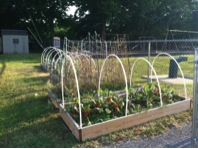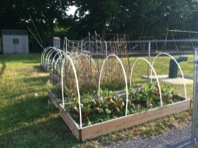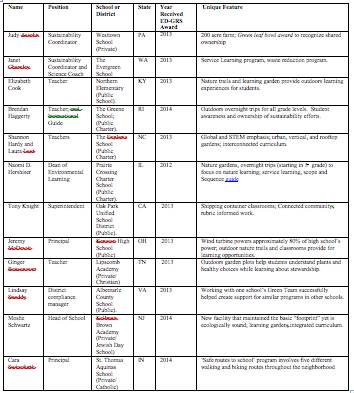Sterrett Imig JSE Nov 2015 Hope Issue PDF [2]
Abstract: Opportunities abound for educators to rethink the way teaching and learning occurs for today’s students. Taking time to focus on learning outdoors, on making healthy choices, and on fostering a sustainable learning and living environment is transforming the way schools work across the nation. Through the lens of the three pillars of the U.S. Department of Education Green Ribbon Schools (ED-GRS), this article described examples from a range of school sites and includes the voices of administrators, teachers, and staff in revisiting how we teach, learn, and lead. Helpful tips regarding school sustainability round out the article to provide “next steps” for the reader.
Key words: US Department of Education Green Ribbon Schools (ED-GRS); green efforts; sustainability; health and wellness; environmental education; outdoors education
Learning Green: Perspectives from U.S. Department of Education Green Ribbon Schools Educators
Pausing with her class on the edge of the school grounds nestled in the rolling hills of Kentucky, the teacher explained the concept of camouflage by pointing out the native flora bordering the nature trails. The upper elementary students gather, listening to the sounds of native insects, and sketch pictures of the landscape. Hundreds of miles away, a wind turbine swooshes silently above the large modern high school in an Ohio suburb, powering 80% of the school’s energy needs while providing energy use data that can be analyzed by students throughout the district. Meanwhile, on the west coast, as students enter a modernized California classroom formed out of shipping containers, the automated lights turn on and off efficiently. Outside, students walk past the rain collecting bioswales that save precious rainwater near the Pacific Ocean. Thousands of miles away, Rhode Island high school students trek through a nearby forest trail as a part of an overnight camping program designed to teach about the region’s great biodiversity.
Since 2012, over 200 schools and districts across the nation have been recognized through the U.S. Department of Education Green Ribbon Schools (ED-GRS) award program that honors public and private schools and districts that are exemplary in the following three pillars:
- Reducing environmental impact and costs, including waste, water, energy use and alternative transportation;
- Improving the health and wellness of students and staff, including environmental health, nutrition, and fitness; and
- Providing effective sustainability education, including robust environmental education that engages STEM, civic skills, and green career pathways (U.S. Department of Education A, n.d.).
In a recent study [3], we researched 75 of these schools and gained insights from principals, teachers, and district leaders who took a lead role in the application process for the ED-GRS distinction (Sterrett, Imig & Moore, 2014). Next, we decided to take a closer look at the leadership involved in these unique schools, with a focus on the distinct characteristics, challenges, and successes of the specific schools. These schools offer hopeful examples for engaging students. Today’s educational leaders are in a unique position to transform their students’ learning experiences by focusing attention, in a collaborative manner, to these three pillar areas.
Director of the U.S. Department of Education Green Ribbon Schools Andrea Suarez Falken has had the opportunity to visit over 80 schools and districts across the United States who have been recognized with ED-GRS distinction. Suarez Falken noted that ED-GRS is “an overarching federal school sustainability communications and outreach tool structured as a recognition award” (personal communication, 2015). She sees ED-GRS as “a powerful convening tool” that allows “federal, state, and local officials, and school communities to celebrate and learn about the honorees’ important work to save money, improve health, and teach by the most hands-on engaging means possible” (personal communication, 2015). Thus, further inquiry regarding these powerful insights and implications are needed to further inform and share out lessons from this work.
Study Design
The researchers utilized purposive sampling in which we selected schools and districts “because of their unique position” (Check & Schutt, 2012, p. 394) as ED-GRS recipients. We then conducted 13 interviews to better understand the unique challenges and benefits associated with ED-GRS schools (or districts) as noted in Table 1, and further cited by each respective interview participant in this study, below. Interviews typically lasted approximately 30 minutes in length, and patterns and themes were noted. Interviews were held on site, via a web-based audio/video portal, or by phone. Selected quotes were transcribed and verified for accuracy, and, when possible, video clips or pictures were collected to expound on key themes. Responses were organized to fit the three ED-GRS pillars and their related elements (U.S. Department of Education [B], n.d.).
These narratives offer practicing principals and teachers insights on how to bolster efforts related to the three ED-GRS pillars. This paper highlights the work—and subsequent benefits—of educators who have made a difference through their roles and in their schools in a transformative way related to sustainability, healthy choices, and outdoors and STEM education. Additionally, the researchers compiled and presented a list of eight strategies to consider when making learning spaces greener.
Table 1 PDF [4]
Pillar 1: Reducing environmental impact and costs
In an age of scarce resources, today’s schools and districts benefit in several ways by reducing waste, conserving energy resources, and lowering costs. Students and staff benefit from healthier learning environments, increased instructional time and financial savings. School leadership is vital in sustainability efforts. As Kensler (2012) noted, “full implementation and evaluation of whole school approaches to sustainability remain rare” (p. 804). Yet, as Hardman (2014) indicated, “with the right mindset and skills, infusing and integrating the principles of sustainability in all aspects of schooling is entirely possible” (p. 36). Pillar 1, Reduced Environmental Impact and Costs, focuses on elements such as the following criteria:
- Reduced or eliminated greenhouse gas emissions, using an energy audit or emissions inventory and reduction plan, cost-effective energy efficiency improvements, conservation measures, and/or on-site renewable energy and/or purchase of green power;
- Improved water quality, efficiency, and conservation;
- Reduced solid and hazardous waste production through increased recycling, reduced consumption, and improved management, reduction, or elimination of hazardous waste; and
- Expanded use of alternative transportation, through active promotion of locally-available, energy-efficient options and implementation of alternative transportation supportive projects and policies (U.S. Department of Education [B], n.d., p. 4).
On the West Coast, Oak Park Unified Schools district superintendent Dr. Tony Knight, a self-described unapologetic environmentalist, observed that “time and finances are key” in the work of reducing environmental impact, and that “changing people’s habits can be difficult, but it can be done.” Knight shared a practical example that is relevant given his school district’s perch over the Pacific Ocean. “Since America has a trade deficit and we have a surplus of shipping containers, we were able to work with a company that took 21 containers and made them into seven classrooms. These are very efficient systems infused with energy-saving innovations such as infrared systems to save energy. Details matter; our carpeting and lighting are efficient and we installed two bioswales in front of each classroom to absorb rainwater to prevent stormwater runoff from simply draining into the Pacific Ocean.”
Dr. Knight’s collaborative efforts with the Oak Park Unified community over the past eleven years have yielded district-level distinction. Knight noted that the ED-GRS process “provided a rubric and helped us change our policies and practices.” His advice? “Make sure the community is connected to the schools, anyway (you) can.”
 [6]
[6]Photograph 1: Shipping containers rebuilt as classrooms at Oak Park Unified School District in California. (Photo credit: Tony Knight)
Meanwhile, across the country in the Great Lakes region, conservation literally powers the school at Kenston High, where Principal Jeremy McDevitt, in Chagrin Falls, OH, has been involved in a collaborative process in securing a wind turbine that powers 80% of the school. He noted that the challenges include five years of pursuing the grant, clearing numerous red tape hurdles, even replacing the turbine due to changing regulations, and a lot of work. The Aeronautica 54-750 Wind Turbine now powers approximately 80% of the high school’s energy needs. Having a superintendent take the lead in this effort was key as McDevitt noted in this short video. Renewable energy helps realize the conservation goals of Pillar 1.
Video Link 1: Pillar One Example (Principal Jeremy McDevitt of Kenston High in Chagrin Falls, OH): https://www.youtube.com/watch?v=DBAZhV3L9Q4 [7]
Pillar 2: Improving health and wellness
Many think of classrooms as four walls, fluorescent lights, and rows of desks. More and more educators, however, realize the importance of healthy learning environments that include good air quality, time spent outdoors, healthy nutrition, and student and staff health and well-being. Pillar 2 emphasizes “Improved Health and Wellness” and focuses on the following criteria:
- An integrated school environmental health program based on an operations and facility-wide environmental management system that considers student, visitor, and staff health and safety in all practices related to design, construction, renovation, operations, and maintenance of schools and grounds; and
- High standards of coordinated school health, including social and psychological services, nutrition, fitness, and quantity of quality outdoor time for both students and staff (U.S. Department of Education [B], n.d., p. 4).
Rhode Island teacher and instructional guide, Brendan Haggerty, organizes hiking and camping trips for students and he noted a “constant effort to get students outside.” As a result, quality outdoor time for students is a part of the school curriculum and a strong component of the school culture. Haggerty observed that looking at the ED-GRS pillars reinforced that “this is what we wanted to be” as a school.
Lead teacher and science coordinator Ginger Reasonover of Lipscomb Academy, a 2013 ED-GRS school in Nashville, TN, explained how each Pre-K and Kindergarten student is given a square-foot plot to learn about a variety of foods, better understand nature, and to learn stewardship. Produce from the garden is served in the cafeteria. Lipscomb works with local “master gardeners” that volunteer to offer expertise in the nature garden.
Video Link 2: Pillar Two Example (Teacher and coordinator Ginger Reasonover at Lipscomb Academy, Nashville, TN): https://www.youtube.com/watch?v=57uyIFNmMbg [8]
These efforts with students can subsequently extend to the family at home as well. Engaged, excited students determined to change eating habits and lifestyle choices can help change a family’s health and wellness priorities.
Pillar 3: Environmental Education
Research shows that students benefit from time spent outdoors. Author Richard Louv (2012), in his best-selling book The Nature Principle, notes that in a time of constant interruptions and ‘connected’ distractions, that “our senses and sensibilities are improved with direct interaction with nature” and that “a more natural environment seems to stimulate our ability to pay attention, think clearly, and be more creative, even in dense urban neighborhoods” (p. 27). The third pillar focuses on “Effective Environmental and Sustainability Education” with the following criteria:
- Interdisciplinary learning about the key relationships between dynamic environmental, energy, and human systems;
- Use of the environment and sustainability to develop STEM content knowledge and thinking skills to prepare graduates for the 21st century technology-driven economy; and
- Development of civic engagement knowledge and skills and students’ application of such knowledge and skills to address sustainability and environmental issues in their community (U.S. Department of Education [B], n.d., p. 4).
At St. Thomas Aquinas School in Indianapolis, IN, Principal Cara Swinefurth explained that their schoolyard garden allows for both stewardship, classroom instruction, and the opportunity to simply learn outside. Swinefurth noted, “If students are going to care for creation, they have to learn about it.” Civic engagement also plays a part in the school’s “Safe routes to school” effort; five different walking and biking routes link the urban school to the surrounding neighborhoods—increasing physical activity and reducing air pollution and energy use—and parent volunteers help oversee the effort.
Teacher and sustainability coordinator Janet Charnley at The Evergreen School in Shoreline, WA, noted that teaching students, at a young age, is critically important when it comes to building a culture of environmental sustainability (which is part of her school’s strategic plan). Teachers develop curriculum, described Charnley, that “promotes flexibility, innovative curriculum, and using the outdoors as a classroom.” This permeates the teaching and learning process. She added, “Students learn at a very young age how to sort waste and then go home and share out this information in a practical way.” She observed that over the past three years, the school has been able to reach a 90% recycling rate and reduce garbage by 50%.
In a report from the Children and Nature Network, Charles and Wheeler (2012) summarized research related to the “benefits derived from children’s experiences of the outdoors and nature—both for their healthy development and the protection of the earth” (p. 1). Some of the studies they highlight include the following:
- There has been a fundamental shift away from nature-based recreation. Pergams and Zaradic (2008) found a decline in nature recreation using data sets including public lands visitation, game licenses, camping, and backpacking/hiking (p. 3).
- Children’s “screen time” has increased substantially. Rideout, Foehr, & Roberts (2010) note that 8-18 year-olds “spend more time with media than in any other activity…. An average of more than 7 ½ hours a day, seven days a week” (p. 1).
- Having nature nearby can serve as a “stress buffer” for children. Wells and Evans (2003) found that “natural areas proximate to housing and schools are essential features in an effort to foster the resilience of children and perhaps to promote their healthy development” (p. 327).
For some educators, teaching outdoors is not just for field trips; it’s an everyday facet of teaching and learning. It involves students and teachers. It involves parents and custodians. It is authentic and engaging. It’s more than simply ‘aligned to the curriculum;’ it is the curriculum. Fostering a love of the outdoors is an essential component at Northern Elementary School in Georgetown, Kentucky. For example, learning about science concepts such as “camouflage” or “adaptations” takes on new meaning when teacher Elizabeth Cook teaches using her school’s nature trail. The school has been recognized for its conservation efforts as well. Thanks to the work of a custodian, a school-wide focus on sustainability served as a catalyst to bring students, staff, and community members together. Northern has received numerous distinctions, such as the 2013 ED-GRS award.
Video Link 3: Pillar Three Example (Teacher Elizabeth Cook, of Northern Elementary School in Georgetown, KY) https://www.youtube.com/watch?v=XyKXGWZ9THw [9]
Key Strategies in Learning Green
Eight key strategies provide opportunities for schools to maximize their work related to the three pillars. For school leaders interested in beginning this work, the following strategies offer guidance.
- Green Team: ED-GRS recipients have found collaborative strength in forming Green Teams. Teachers, administrators, custodial staff, parents, students, community members form the Green Team as it should be a diverse group of people with one thing in common – a genuine interest in the green movement. These individuals bring ideas, energy and effort to the process. Our research has shown that Green Teams help to develop and implement green initiatives, but their real value comes in terms of sustaining school initiatives. As the district environmental compliance manager of Albemarle County Schools (VA), Lindsay Snoddy worked with a team at Stony Point Elementary that received the ED-GRS distinction in 2013. “Teamwork is more important than I originally estimated,” Snoddy noted. “In my district role, I can certainly be involved in the district work, but you need an active approach at the school level to be successful.” Forming a “Green Team,” as some schools call it, takes leadership and multiple voices, including teaching staff, parents, and students.
- Energy Savings: In today’s educational climate, any initiative that actually results in cost savings is likely to garner the support of school and district leaders. Many ED-GRS winners started their school evolution focused on saving energy and ultimately money. At its most basic level, energy conservation can be simply teachers and students being more mindful of classroom lights and temperature. This mindfulness can quickly snowball into replacing lighting systems, installing motion sensors, installing solar panels, replacing inefficient classrooms or entire buildings, and possibly even erecting your own wind turbine. An obvious and gratifying benefit of this strategy is that metrics (power consumption and costs) are readily available to chart the effectiveness of any effort, and students can be involved with tracking these metrics and administrators appreciate the savings. Teacher Shannon Hardy at The Exploris School, a public charter K-8 school in Raleigh, NC, noted that the ED-GRS process encouraged reflection on resources. Hardy explained, “There is an awareness, as a charter school, if we can save money on electricity and utilities, it can go right into instruction.” See Hardy discuss this in the link below:
Video Link 4: Energy Savings Example (Teacher Shannon Hardy of The Exploris School in Raleigh, NC) http://youtu.be/p895rRx_5sE [10]
- Waste Reduction: Much like energy saving, the measurable effects of waste reduction are immediately apparent and rewarding. ED-GRS recipients have tackled lunch waste by encouraging recycling programs, food composting stations, and the use of reusable containers. Classroom waste can be reduced with increased awareness of copies made and transitioning to online assignments. As with energy savings, the effects of waste programs can be easily measured through cost savings and sheer volume of waste produced. Judy Nicholson Asselin, the Sustainability Coordinator for Westtown School in West Chester, PA that is located on a 600-acre campus, observed, “It’s all about waste.” Students focus on sustainability from pre-kindergarten through 12th grade through an ethical lens. Asselin noted that “cutting our electricity use, improving waste diversion, and reducing the carbon footprint of food coming to campus have all reduced carbon emissions” and thus reduced costs.
- Outdoor Learning Garden: A small plot of ground (in fact as little as a square foot per student), some basic gardening supplies, some manual labor and you have the power to open up a whole new world of learning to your students. Our findings indicate outdoor gardens can thrive in any environment and offer a curricular experience that can capture the attention of nearly every child. For Ginger Reasonover’s students, a square foot garden plot opened up new possibilities and perspectives. When students are able to work outside and take ownership of their school grounds, increased engagement and pride can result.
 [11]
[11]Photograph 2: At Lipscomb Academy (Nashville, TN) Pre-K and K Students learn stewardship by maintaining their own garden plots. Produce from the gardens is introduced into the cafeteria in menu items ranging from pizza to fruit and veggie smoothies.
- Nature Trails and Outdoor Classrooms: School is more than a brick and mortar facility and learning can often be inspired outside of the classroom. Many Green Ribbon schools have developed nature trails and outdoor classrooms to increase student and teacher engagement and enhance curriculum. Many of these trails require minimal maintenance, yet they maximize time spent outdoors and on school grounds. The school leader might invite the buildings and ground manager and a local landscaping expert to weigh in on possibilities to enhance outdoors learning areas.
 [12]
[12]Photograph 3: This learning trail at Northern Elementary School in Georgetown Kentucky, allows teachers like Elizabeth Cook to have a constant, year-round opportunity to teach concepts related to content standards.
- Student and faculty health initiatives: For all of the wonderful things that can happen in our nation’s schools, they can also be a source of harm. From fluorescent lights in the ceilings, toxic chemicals on the floors, poor ventilation, unhealthy lunches and bunches of stress, schools can be harmful to the health and well-being of those they serve. By focusing attention on the improvement of the school environment, and the physical health of students and teachers, schools can again see tangible and measurable success. Teacher Laura Laut of The Exploris School in Raleigh, NC noted the power of connecting healthy initiatives with service learning in the video link below:
Video Link 5: Service Learning Example (Teacher Laura Laut of The Exploris School in Raleigh, NC) http://youtu.be/WIM0y8XkvT8 [13]
- Curriculum alignment: At Prairie Crossing Charter School in Grayslake, IL, Dean of Environmental Learning Naomi Hershiser ensures that the environment and outdoor learning is integrated into the students’ work. Hershiser stated, “Writing, observing, sketching is built in every week. The PCCS Curriculum Overview [14] is integrated within all aspects of teaching and learning and is grounded in nature learning.” As the overview link shows, the alignment of the curriculum encourages getting outside to make observations and predictions and to better understand the natural habitat.
- Sharing the message: Westtown School’s Asselin explained, “It feels good to do the right thing, it saves money, and it even impacts admissions.” “The main thing is to get our public schools engaged….As an independent Quaker school, we strive not to be elite and separate, but we are innovators who are setting the agenda to move this work forward. I don’t like the artificial distinction between public and private- we can share many of these key goals and efforts.” Moshe Schwartz, Head of Kellman Brown Academy in Voorhees, NJ, noted that the ED-GRS experience has “provided great publicity” and comes, in no small part, from the fact that Kellman Brown has engaged partnerships with groups such as Jewish Farm School, an urban farming program in Philadelphia, and Project Learning Tree through the State of New Jersey Forest Resource Education Center and Department of Environmental Protection. To help spread the word about “Boomerang Lunch” at Kellman (the motto for this waste-free Friday lunch is “What comes in must go back home!”), Schwartz invited local Voorhees Mayor Michael Mignogna to come, have lunch, and leave “ZERO Waste”!
Getting Started
For the teacher or principal who aspires to bolster green efforts, simply getting started can be overwhelming. We asked Deborah Moore, Executive Director of the Green Schools Initiative [15] in Berkeley, CA and co-author of our 2014 study, the following question: “Where does a school leader get started when it comes to greening the school?” Here are five key areas Deborah focused on as considerations (personal communication, 2015):
Form a Green Team- Moore noted the importance of forming a ‘Green Team’ that represents the diverse strengths and potentials of the school community. The significant work involved in focusing on, and maintaining, green initiatives will take the insights, energy, and collaboration of school leaders (including teachers), parents, building and grounds staff, local civic leaders, and, of course, students.
Consider “place and passion”– Each school has unique traits and qualities, including location. The “place” of a school will often determine the “passion” of the school community. Moore stated that principals need to “take the pulse of teachers and parents and find out what is most exciting and relevant to their particular school.” She explained that environmental pathways and systems such as water, climate, waste, food, and health are ultimately connected, and the school community must be involved in considering what is most important to them. One school may have a focus on saving energy, another on reducing litter around the building and grounds, and yet another on childhood asthma and eliminating toxic chemicals. Finding what the school community is most passionate about is important in building ownership and engaging active participation.
Foster curriculum integration– Moore encouraged educators to reflect on and assess their existing academic curricula, standards, and desired student learning outcomes, and consider ways to integrate green efforts so that it is not an extra burden. For example, math standards can be met through student energy or waste audits. Science standards for observation, earth systems, biology, or chemistry can be met with hands-on experiments in outdoor classrooms or gardens. History and social studies curricula – the Industrial Revolution or European colonization of the Americas, for example – can include discussion about environmental themes and impacts on economics and communities.
Consider overall health– Moore noted that green schools are “fundamental to a high quality 21st century education” because children spend the majority of their waking hours indoors in school. She points out that “the quality of their learning environment affects their ability to learn and grow” and she encouraged leaders to consider the overall health of the learning environment, including details such as the upkeep and cleanliness of the building, air quality, and even natural light. The Green Team can help assess school facilities, operations, and curricula – from what students eat to where students play – and suggest improvements.
Start small– Moore points to the benefits of realizing “quick wins” in starting to green the school. This might involve, for example, clearing and re-planting a learning garden area, working with volunteers to clean up litter and organize a recycling program, promoting a simple “turn it off” energy and cost-savings campaign, or partnering with local farmers to use locally-grown produce in the cafeteria. Realizing small, visible successes that engage and inspire students within one school year can help build momentum in identifying more in-depth and long-term planning efforts.
Assess Progress– The application process itself can help foster reflection and serve as a catalyst for making necessary changes to better meet the requirements of the three pillars. Much as the Hawthorne effect explained that individuals modify their behavior when they know they are being observed, engaging in the various states’ ED-GRS application process can help to focus schools and further green behaviors. Suarez Falken noted that “Each state is free to devise its own selection process” (personal communication, 2015) in this work. The application process challenges school personnel to reflect on and document the curricular, environmental, and health benefits experienced by going green. Superintendent Tony Knight observes that initially his school district was unsuccessful, but in trying again the next year the ED-GRS rubric “helped us change our policies and practices, and we were able to hit the points on the rubric” and successfully become the first district in California to receive the award. According to ED-GRS recipients, this effort can often raise the powerful question, “What if?” What if we expand our efforts? What if we rethink our programs? What if we want to improve further?
These important questions regarding school sustainability efforts offer the promise of hope and growth for schools ready to work collaboratively together. Leadership is vitally important and it involves students, teachers, staff, principals, district leaders and community members. Today’s educational leaders are uniquely poised to realize meaningful change in their school communities by leveraging these three pillars. Leveraging both collaboration and time is critically important in shifting the focus to thinking of learning outside the classroom (Sterrett, 2011; Sterrett 2013). Fortunately, perspectives from educational leaders engaged in this important work can help us understand the possibilities of engaging in these green efforts. As Kensler and Uline (2014) noted in the recent National Action Plan for Educating for Sustainability [16], raising awareness of sustainability efforts as well as increasing leadership capacity in school and district leaders are both important, noting that “Formal school leaders, including school district superintendents, school principals, and other district-level administrators, play especially important roles because they serve as gatekeepers of change: they can either facilitate or impede change efforts” (p. 20). As the examples in this paper highlight, change agents are indeed present; learning from their leadership can help us impact other school communities in powerful ways.
References
Charles, C., & Wheeler, K. (2012). Children & Nature Worldwide: An Exploration of Children’s Experiences of the Outdoors and Nature with Associated Risks and Benefits. Children & Nature Network. Report retrieved on June 9, 2014 from http://www.childrenandnature.org/documents/C118/ [17]
Check, J. & Schutt, R. K. (2012). Research methods in education. Thousand Oaks, CA: Sage.
Hardman, J. (2014). Leading for regeneration and sustainability in schools: No child left inside- elementary school principal. A phenomenological case study.
Kensler, L. A. W. (2012). Ecology, democracy, and green schools: An integrated framework. Journal of School Leadership, 22 (4), 789-814.
Kensler, L. A. W., & Uline, C. (2014). Leadership. In D. Sobel, S. J. Gentile, & P. Bocko (Eds.), National Action Plan for Educating for Sustainability (pp. 20-21). Retrieved on October 6, 2015 from http://www.centerforgreenschools.org/sites/default/files/resource-files/National-Action-Plan-Educating-Sustainability.pdf [16]
Louv, R. (2012). The nature principle. Chapel Hill, NC: Algonquin Books.
Pergams, O. R. W., & Zaradic, P. A. (2009). Evidence for a fundamental and pervasive shift away from nature-based recreation. Report retrieved on June 9, 2014 from http://www.videophilia.org/uploads/PNAScomplete.pdf [18]
Rideout, V. J.; Foehr, U. G.; & Roberts, D. F. (2010). Generation M2: Media in the lives of 8-18 year-olds. Henry J. Kaiser Family Foundation. Menlo Park, CA. Report retrieved on June 9, 2014 from http://kaiserfamilyfoundation.files.wordpress.com/2013/04/8010.pdf [19]
Wells, N. M. & Evans, G. W. (2003). Nearby nature: A buffer of life stress among rural children. Environment and Behavior, 35 (3), 311-330.
Sterrett, W. (2011). Insights into action: Successful school leaders share what works. Alexandria, VA: ASCD.
Sterrett, W. (2013). Short on time: How do I make time to lead and learn as a principal? Alexandria, VA: ASCD.
Sterrett, W.; Imig, S.; & Moore, D. (2014). U.S. Department of Education Green Ribbon Schools: Leadership insights and implications. E-Journal of Organizational Learning and Leadership, 12 (2), 2-18.
U.S. Department of Education [A] (n.d.). Green Ribbon Schools Fact Sheet. Retrieved on June 9, 2014 from http://www2.ed.gov/programs/green-ribbon-schools/factsheet.pdf [20]
U.S. Department of Education [B] (n.d.). “Criteria for U.S. Department of Education Green Ribbon Schools” Document retrieved on October 16, 2014 from http://www2.ed.gov/programs/green-ribbon-schools/criteria.doc [21]
Acknowledgements: The authors would like to thank Deborah Moore, Executive Director of the Green Schools Initiative in Berkeley, CA for her insights, as well Director of the U.S. Department of Education Green Ribbon Schools Andrea Suarez Falken for her contribution as well. We would like to acknowledge Michael MacGovern for his early assistance in this study. We would also like to acknowledge educators Judy Nicholson Asselin, Janet Charnley, Elizabeth Cook, Brendan Haggerty, Shannon Hardy, Naomi D. Hershiser, Tony Knight, Laura Laut, Jeremy McDevitt, Ginger Reasonover, Lindsay Snoddy, Moshe Schwartz, and Cara Swinefurth for their insights and contributions to this manuscript.

